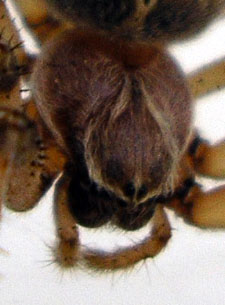A very familiar spider, but could I find out what species this is? I started at the Canadian Arachnologist website, went to the Nearctic Spider database, and started looking around. There are a lot of spiders. I looked around at some and decided that this spider is probably in the genus Araneus, so I used the nice tool on the website for building a list of species for a particular region, which produced eleven species in the genus.

Unfortunately not all have images and descriptions. The closest I could find to my porch spider was the marbled orbweaver, a smaller spider, but with a similar look, which gave me some confidence in the genus guess.

This spider spins an orb web, is not active early in the day (when the sun shines on the porch), and spins a case for her eggs, which she attaches to the corner where the roof of the porch meets the wall. If you have an idea of what species this spider is, please let me know.






6 comments:
We have one on our deck that is very close to your photo - some minor differences - will be watching to see what you discover about identifying yours
That spider is more likely Larinioides cornutus (Clerck, 1757). The species page for that one in the Nearctic Spider Database is: http://canadianarachnology.dyndns.org/data/spiders/16288.
David, Thanks for dropping by. I took a look at the spider you suggest. But the eyes look quite different and markings are different. Also my porch spiders lay eggs in the fall, and are about twice the size of the species you suggest. Could there be that much variation within the species?
Pamela,
Indeed, colour variations in most orbweavers can be quite dramatic. Males are very different from females and these patterns can vary by geography, altitude, and the seasons. I'm not aware if L. cornutus builds eggsacs in the autumn, though this doesn't mean it can't happen. I do know that adults and various stages of immatures can overwinter, which might suggest that egg laying schedules might also be variable. Strangley, spiders will often lay unfertilized eggs and tend these with silk coverings as though they were fertilized. Have a go at searching for this species in Google and you'll see quite a variety of body colorations. As for your spider being twice the size as that described in the species page in the database, then sadly, I might be wrong with my tentative ID. Unfortunately, the only definitive way to put a name on this one is to have a good close look at the reproductive parts and compare these to the drawings Pierre Paquin has posted here: http://web.pdx.edu/~pdx02141/Quebecspiders/Fam_lists/List_Araneidae.html
...sorry about that, I forgot to tag the URL...
http://web.pdx.edu/~pdx02141/Quebecspiders/Fam_lists/List_Araneidae.html
Thanks, David. I checked the link and cruised around looking for spiders--got dizzy with it, went outside and saw that one of my spiders was posing for a photo of her ventral surface. I got pictures and put them up in a new post, hoping that the pattern will help nail this down.
Post a Comment